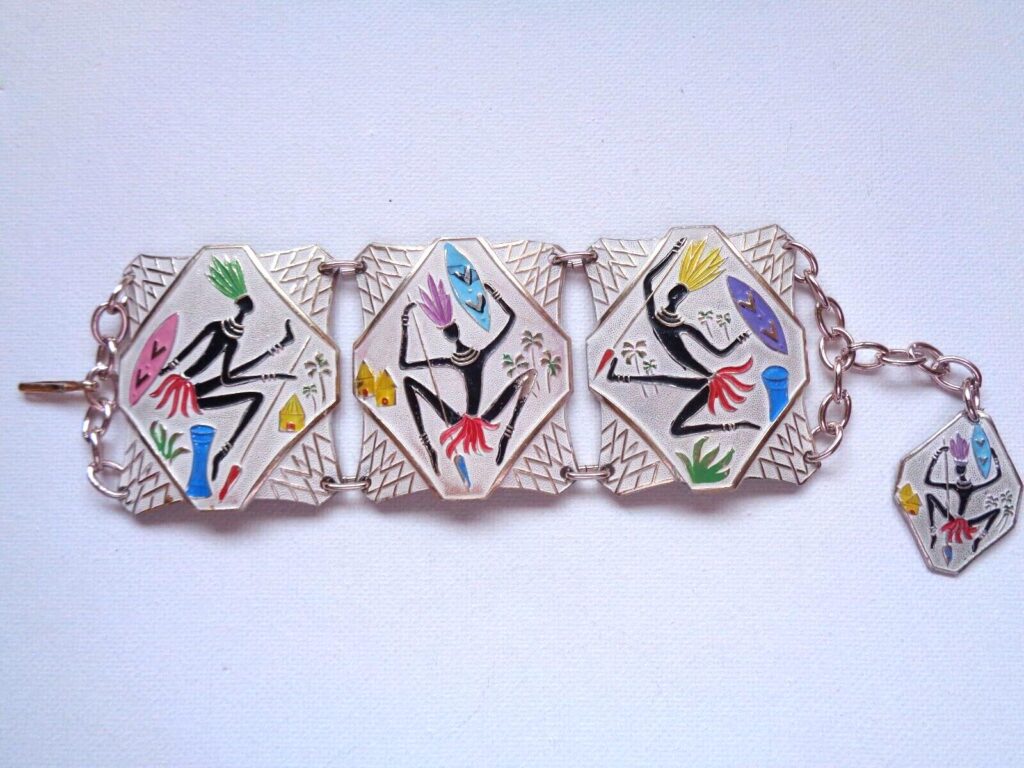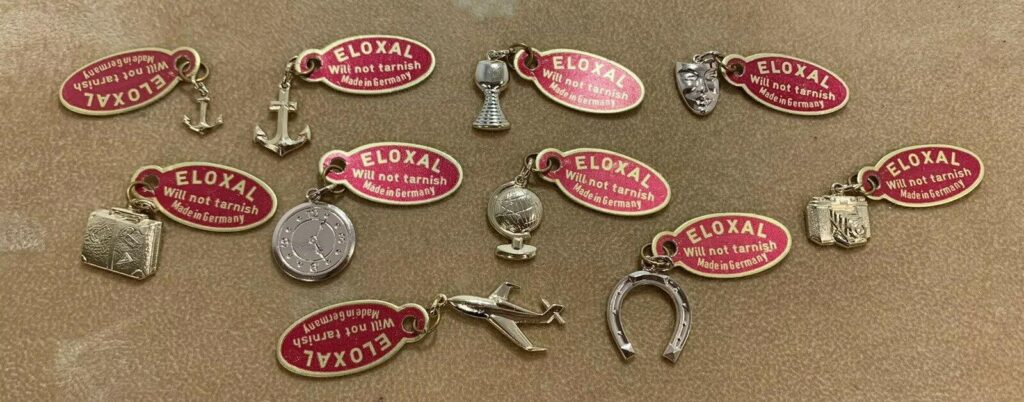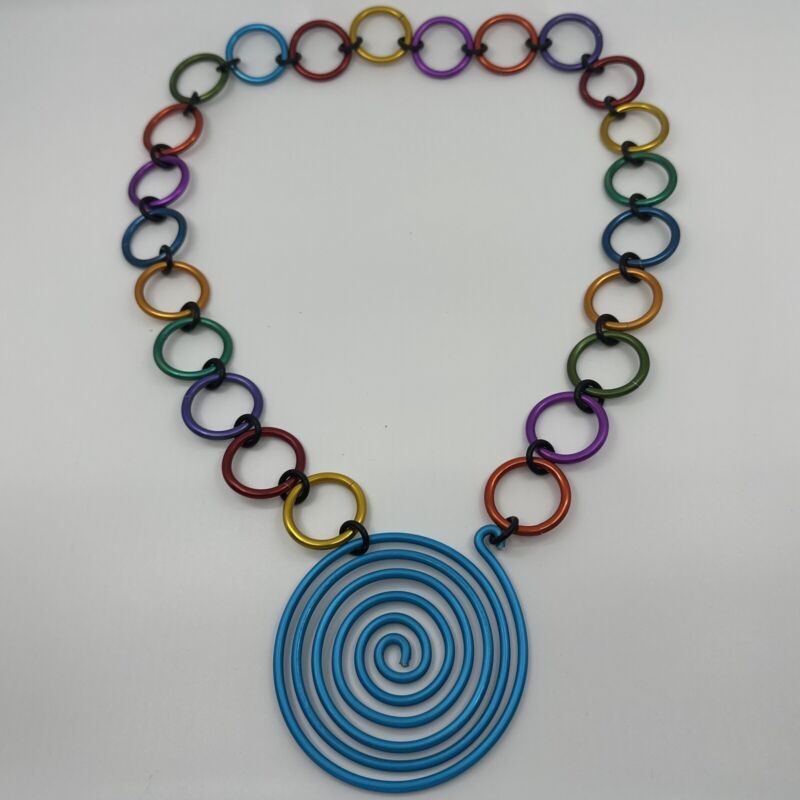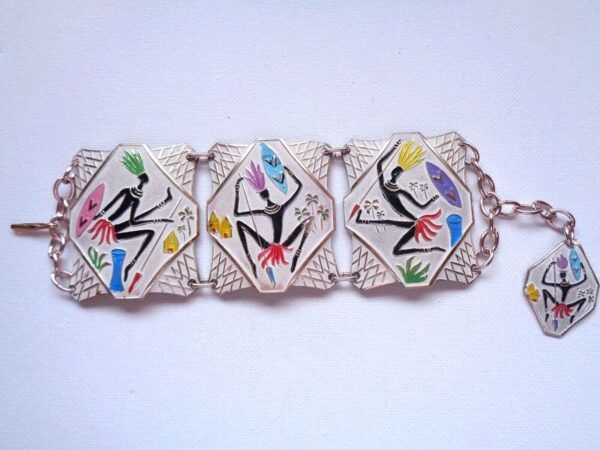#Aluminum #Jewelry #Buy #Leave #WorthPoint

Colorfully decorated bracelet in a classic aluminum style.
What? Jewelry made from aluminum? Why, yes, it’s a thing. In fact, it’s been around for a really long time. If you’re a lover of many different types of vintage wares, this probably doesn’t come as a surprise. You’ve likely run across hammered aluminum household goods dating to the first half of the 20th century or some colorful mid-century anodized aluminum cups and other serveware as you’ve shopped flea markets and estate sales. It stands to reason that jewelry was made of aluminum back then as well, and it didn’t stop there.
When it comes to buying aluminum jewelry or leaving it behind, there’s not a one-size-fits-all answer. Looking at the spectrum of aluminum jewelry wares will help you decide which of these lightweight designs to snap up if given the chance.
The Oldest Aluminum Jewelry
Even though aluminum oxide was discovered in the 1820s, it took a few decades to make it commercially viable. By 1857, aluminum goods were being shown at the Paris Exhibition of 1857.
During the Victorian era, when aluminum was coveted and quite expensive, it was cast into shapes and linked or riveted together to form adornment. Some pieces combined karat gold with aluminum and were very finely crafted. They’re often very shiny since aluminum doesn’t tarnish like other silver-colored metals. Other embellishments can include mother of pearl and turquoise. These pieces don’t come on the market frequently, but they are worth buying when you get the chance, as they sell for anywhere from a few hundred to a few thousand, depending on the intricacy and craftsmanship.
Another thing worth mentioning is that sometimes chromium-plated filigree pieces dating to the early 1900s are sold as aluminum. These were made to mimic the look of white gold filigree, and the finish is always very shiny despite their antique status. Filigree is also light in weight by nature; there just isn’t much metal there to give it heft. Regardless, these are not crafted of aluminum.
Eloxal Jewelry from Germany
When avid costume jewelry collectors think of aluminum jewelry, Eloxal usually comes to mind. What does that mean exactly? Jewelry made in West Germany using the electrolytic oxidation of aluminum process was often marketed with paper tags reading Eloxal. This material is very light in weight, and as the paper tags stated, it will not tarnish. Thus, larger bracelets and pairs of earrings that might be heavy to wear if made of other types of metal were more comfortably donned when made with this aluminum alloy.
Most of these items made from the mid-to-late 1940s and through the 1950s are marked Germany or W. Germany. Some pieces will have other marks on them, such as Junolite. They can be silvery in color or gold plated, and some have cold-painted enamel accents. Some styles are even molded to look like they’re set with marcasites.

Eloxal aluminum charms with original tags.
Eloxal is the most common type of aluminum jewelry you’ll run across. Because it feels so light and may not have any embellishments at all, it can be easy to skate over when poring over jewelry. Is that a good idea? Sometimes, yes.
Plain pieces of aluminum jewelry like chain necklaces and bracelets are a hard sell, as are small, inexpensive-looking brooches. Most experienced jewelry sellers don’t bother with them but will stock the larger Eloxal bracelets and clip earrings with more style. Another thing to remember is that this type of metal is pliable, so it can bend and break. Look for signs of damage before buying a piece that appeals to you. Lastly, don’t overpay. Even the best-looking Eloxal bracelets don’t usually bring more than $25-40 apiece when sold online.
1980s and ‘90s Aluminum Jewelry
After an absence of bold adornment in the late 1970s, the ‘80s offered many selections, including some really interesting aluminum pieces. One of the designers working in aluminum was Glen Yank. His edgy designs appealed to bikers and the punk rock set back when they were new. These are worth buying since most of his earrings sell for $50; bracelets bring more, with the most interesting cuffs and sets of bangles selling for $200-300. Other jewelry inspired by Yank’s designs were made as well, including pieces crafted of anodized aluminum in various colors. These can also sell in excess of $100, so watch for them.

Glen Yank earrings crafted of aluminum in the 1980s.
Speaking of anodized aluminum, also watch for jewelry designed by David Spada in the early ‘90s. Spada was known for creating “Freedom Rings,” which are rainbow-colored circles representative of gay pride. The colorful aluminum rings were used on key chains but also made into earrings, bangle bracelets, and necklaces. He branched out to include spirals of aluminum in his designs, and some were made in colors beyond the initial red, orange, yellow, green, blue, and purple of his Freedom Rings. Most of the jewelry marked Spada sells in the hundreds. And while it’s not easy to find, more of these pieces have entered the secondary marketplace over the past few years.

Fine Jewelry Made of Aluminum
Yes, aluminum has even been used for fine jewelry production. One of the main makers of sought-after aluminum pieces richly plated with gold is Joel Arthur Rosenthal, who marks his jewelry JAR. Several other brands and designers of distinction have been featured in the media for using anodized aluminum for at least part of the metal in jewelry set with precious gemstones, including sparkling diamonds. Other metals just can’t hold color, like aluminum, and those with a creative eye find that aspect appealing.
Are these aluminum pieces the types of things you’ll run across shopping thrift stores? Probably not. They’re good to be aware of, though, because you never know when someone will unknowingly toss a valuable treasure made of aluminum into a resale shop bargain bin.
Pamela Siegel is a freelance writer and author who has been educating collectors for more than two decades. In addition to three books on topics relating to antiques and collectibles, she frequently shares her expertise through online writing and articles for print-based publications. Pamela is also the co-founder of Costume Jewelry Collectors Int’l (CJCI) and the proprietor of Chic Antiques by Pamela.
WorthPoint—Discover. Value. Preserve.




